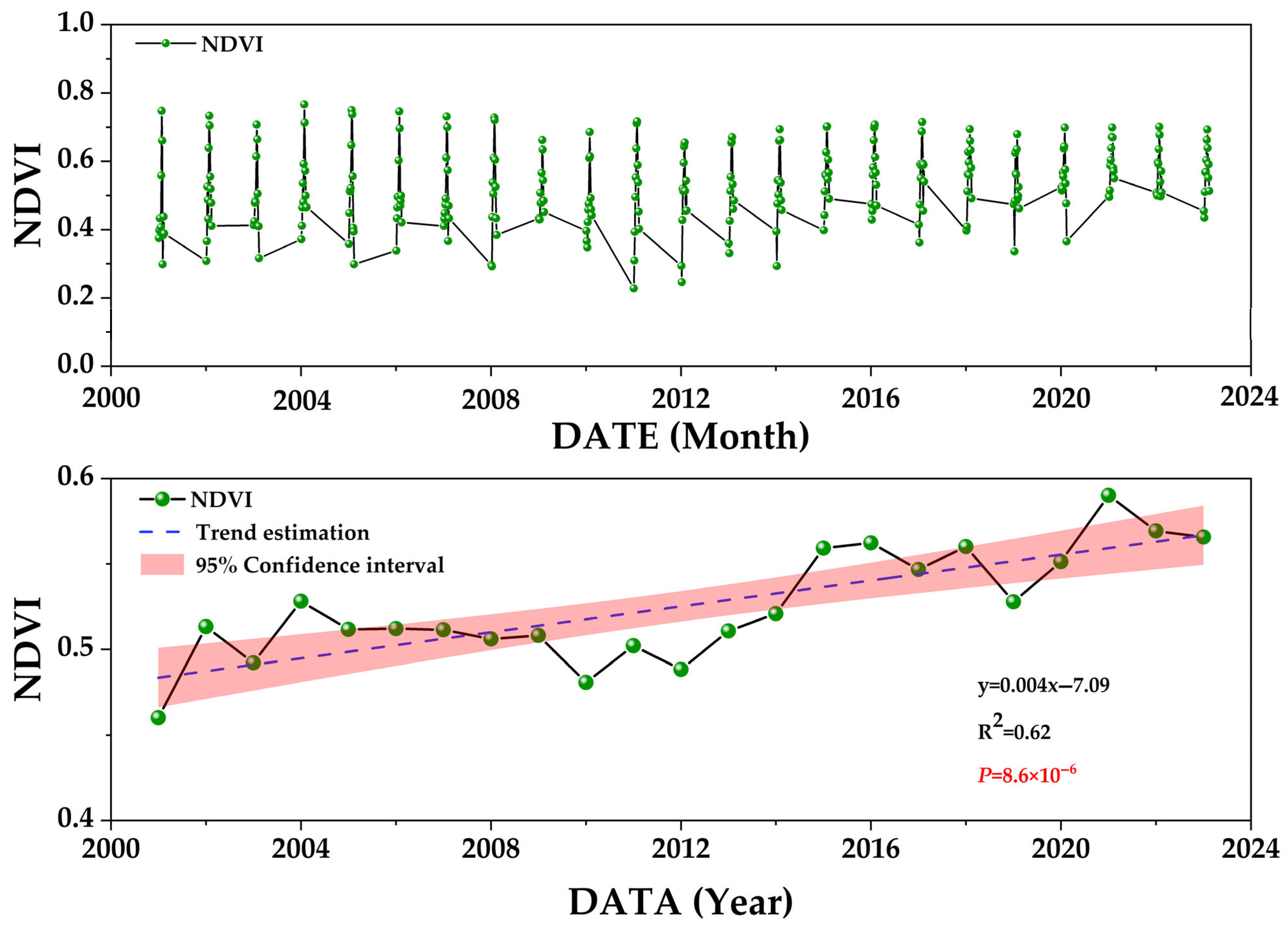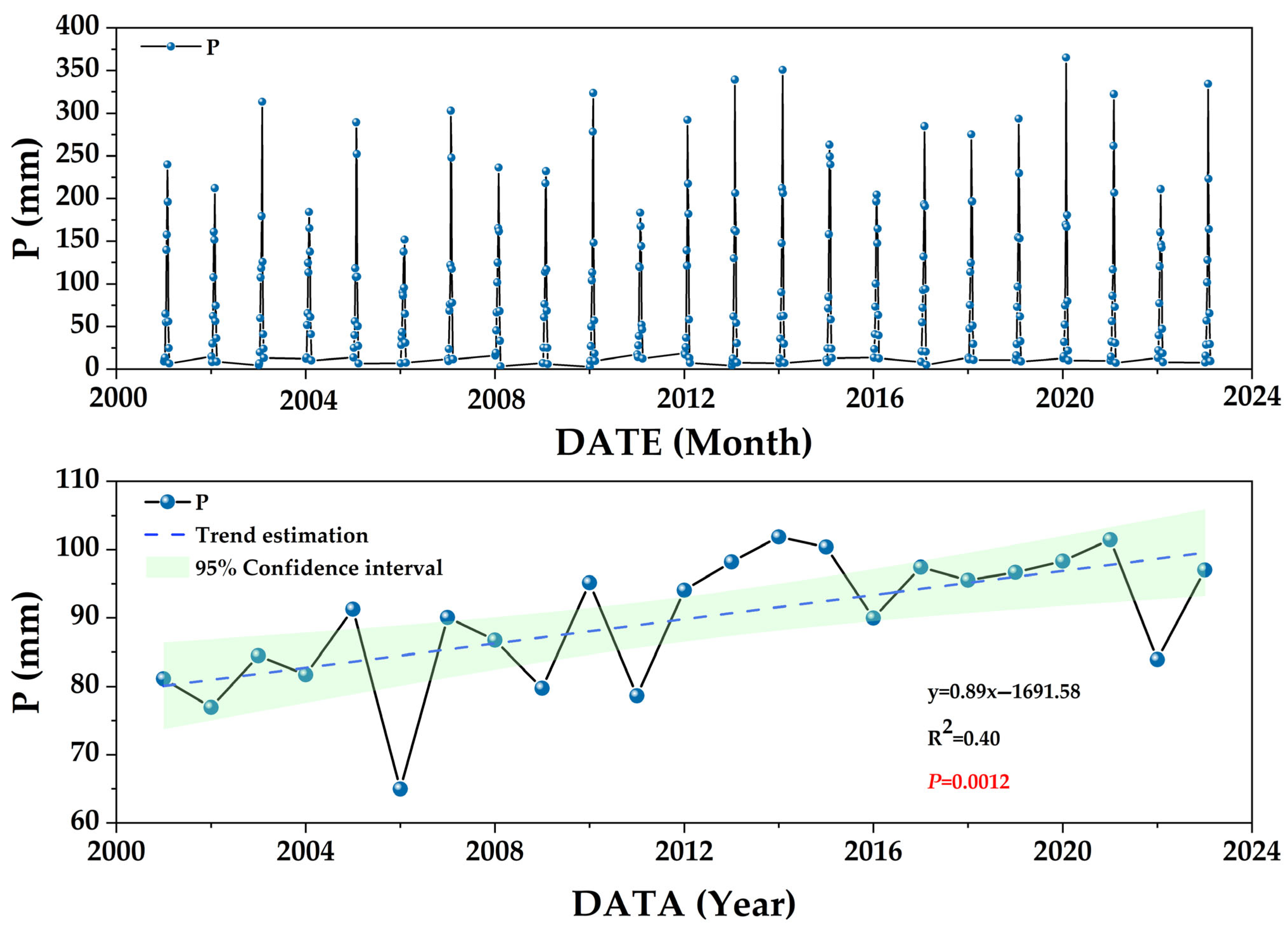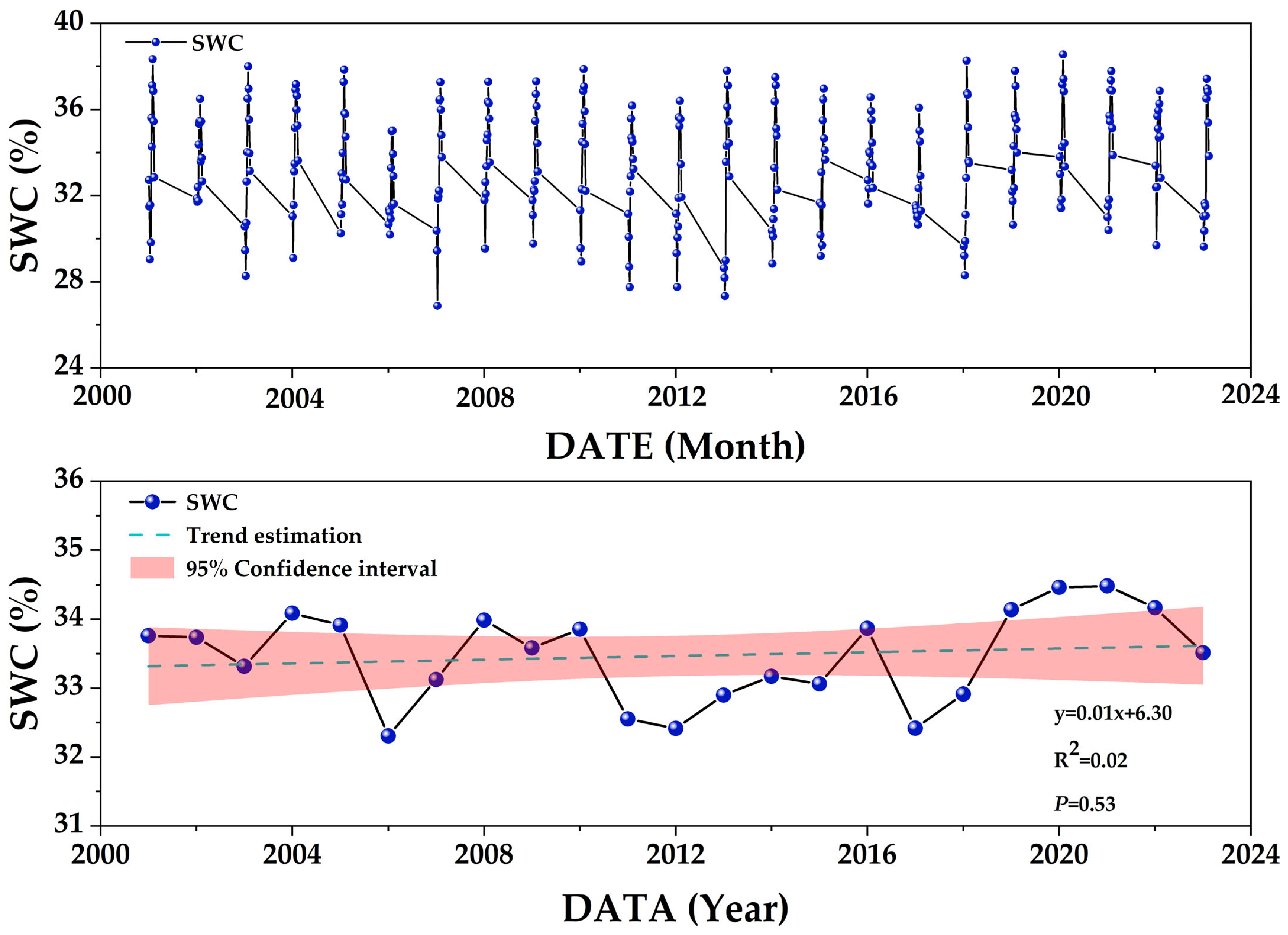Exploring NDVI Responses to Regional Climate Change by Leveraging Interpretable Machine Learning: A Case Study of Chengdu City in Southwest China
Abstract
1. Introduction
2. Materials and Methods
2.1. Study Area
2.2. Data and Preprocessing
2.3. Statistical Analysis
2.3.1. Analysis of Time Series Distribution Characteristics
2.3.2. Time Autocorrelation Test
2.3.3. Interpretable Machine Learning
- (1)
- Random Forest (RF)
- (2)
- BP Neural Network
- (3)
- Support Vector Machine (SVM)
- (4)
- Extreme Gradient Boosting (XG-Boost)
- (5)
- Model accuracy evaluation
2.3.4. Determination and Prediction of the Dominant Climate Factors
- (1)
- SHAP analysis
- (2)
- Contribution analysis
3. Results
3.1. Vegetation Variations in the Time Series
3.2. Variations in the Environmental Factors in the Time Series
3.2.1. Precipitation
3.2.2. Air Temperature
3.2.3. Wind Speed
3.2.4. Soil Volumetric Water Content
3.3. Responses of Environmental Factors to Vegetation and Predictions on the Basis of Interpretable Machine Learning
3.3.1. Evaluation of the Simulation Accuracies of Different Machine Learning Models
3.3.2. Influences of Environmental Factors on the Changes in the NDVI
4. Discussion
4.1. Climate-Driven Mechanisms of NDVI Changes
4.2. Predicting the Effectiveness of NDVI Changes on the Basis of Explainable Machine Learning
5. Conclusions
Author Contributions
Funding
Institutional Review Board Statement
Informed Consent Statement
Data Availability Statement
Acknowledgments
Conflicts of Interest
References
- Das, S.; Kamruzzaman, M.; Md, A.R.; Islam, T. Assessment of characteristic changes of regional estimation of extreme rainfall under climate change: A case study in a tropical monsoon region with the climate projections from CMIP6 model. J. Hydrol. 2022, 610, 128002. [Google Scholar] [CrossRef]
- Kang, J.M.; Zhang, Q.; Zhang, B.L.; Hu, Y.M.; Zhang, C.Y.; Li, C.L. Dual impacts of urban expansion on the carbon sequestration capacity of urban vegetation: A multi-scale global study. Ecol. Indic. 2025, 176, 113746. [Google Scholar] [CrossRef]
- Qi, G.Z.; Song, J.X.; Chen, S.Z.; Gong, Y.F.; Bai, H.Y.; She, D.X.; Xia, J.; Fu, Y.S.H. Increasing impacts of compound extreme droughts on vegetation productivity in China. J. Hydrol. 2025, 660, 133447. [Google Scholar] [CrossRef]
- Yan, M.L.; Lu, J.Y.; Ma, Y.Y.; Ma, C. A remote sensing evidence on the marginality, stagementation and spatiotemporal heterogeneity of vegetation evolution characteristics in the Yinshan Mountains, China: Based on PKU GIMMS NDVI (1984–2022). Ecol. Indic. 2025, 171, 113193. [Google Scholar] [CrossRef]
- Zhu, L.J.; Meng, J.J.; Zhu, L.K. Applying Geodetector to disentangle the contributions of natural and anthropogenic factors to NDVI variations in the middle reaches of the Heihe River Basin. Ecol. Indic. 2020, 117, 106545. [Google Scholar] [CrossRef]
- Gong, X.L.; Du, S.P.; Li, F.Y.; Ding, Y.B. Study of mesoscale NDVI prediction models in arid and semiarid regions of China under changing environments. Ecol. Indic. 2021, 131, 108198. [Google Scholar] [CrossRef]
- Zhou, Z.H.; Jin, J.X.; Yong, B.; Huang, W.D.; Yu, L.; Yang, P.Q.; Sun, D.C. Enhanced NDVI prediction accuracy in complex geographic regions by integrating machine learning and climate data—A case study of Southwest basin. Int. J. Appl. Earth Obs. 2025, 139, 104498. [Google Scholar] [CrossRef]
- Hussain, A.; Liu, H.Z.; Cao, J.H.; Yang, H.; Rezaei, A.; Wang, P.; Luo, Q.K.; Zhou, M.X.; Liang, Z. Recent increase in soil moisture levels concerning climate variability in the karst region of southwest China using wavelet coherence and multi-linear regression. Gondwana Res. 2025, 141, 40–54. [Google Scholar] [CrossRef]
- Mohammadi, S.; Karimi, S.; Mohammadi, A.A.; Moghanlo, S.; Alavinejad, M.; Saleh, H.N.; Mohammadi, H.; Hashemi, M.N.; Kisi, O. Prediction of climate change on surface water using NARX neural network model: A case study on Ghezel Ozan River, Northwest, Iran. Desalin. Water Treat. 2023, 304, 112–128. [Google Scholar] [CrossRef]
- Li, T.; Wu, Y.; Ren, F.; Li, M.Y. Estimation of unrealized forest carbon potential in China using time-varying Boruta-SHAP-random forest model and climate vegetation productivity index. J. Environ. Manage. 2025, 377, 124649. [Google Scholar] [CrossRef]
- Wang, Y.Y.; Chen, X.; Gao, M.; Dong, J.Z. The use of random forest to identify climate and human interference on vegetation coverage changes in southwest China. Ecol. Indic. 2022, 144, 109463. [Google Scholar] [CrossRef]
- Thakur, C.; Budamala, V.; Kasiviswanathan, K.S.; Teutschbein, C.; Soundharajan, B.S. Extreme gradient and boosting algorithm for improved bias-correction and downscaling of CMIP6 GCM data across Indian river basin. J. Hydrol.-Reg. Stud. 2025, 59, 102443. [Google Scholar] [CrossRef]
- Coskun, S.; Akbas, A. Revealing the future complexity of urban water scarcity and drought via support vector machine: Case from semi-arid Bursa urban area. Urban Clim. 2024, 58, 102211. [Google Scholar] [CrossRef]
- Bai, X.L.; Zhang, Z.W.; Gu, D.Q. Driving mechanism of natural vegetation response to climate change in China from 2001 to 2022. Environ. Res. 2025, 276, 121529. [Google Scholar] [CrossRef] [PubMed]
- Zhong, R.; Wang, P.F.; Mao, G.Q.; Chen, A.F.; Liu, J.G. Spatiotemporal variation of enhanced vegetation index in the Amazon Basin and its response to climate change. Phys. Chem. Earth 2021, 123, 103024. [Google Scholar] [CrossRef]
- Liu, M.; Zhai, H.L.; Zhang, X.C.; Dong, X.F.; Hu, J.X.; Ma, J.Y.; Sun, W. Time-lag and accumulation responses of vegetation growth to average and extreme precipitation and temperature events in China between 2001 and 2020. Sci. Total Environ. 2024, 945, 174084. [Google Scholar] [CrossRef] [PubMed]
- Liu, Y.; Liu, H.H.; Chen, Y.; Gang, C.C.; Shen, Y.F. Quantifying the contributions of climate change and human activities to vegetation dynamic in China based on multiple indices. Sci. Total Environ. 2022, 838, part 4. 1–12. [Google Scholar] [CrossRef]
- Xiong, Y.F.; Zhang, A.L.; Liu, M.B.; Zhang, X.; Cheng, Q. Drought risk assessment for citrus and its mitigation resistance under climate change and crop specialization: A case study of southern Jiangxi, China. Agr. Water Manag. 2024, 306, 109195. [Google Scholar] [CrossRef]
- Wang, S.P.; Zhang, Q.; Liu, Y.Z.; Yue, P.; Wang, J.S. Effects of global warming on drought onset in China. J. Hydrol. 2024, 632, 130964. [Google Scholar] [CrossRef]
- She, Z.Y.; Liu, Z.Y.; Cai, H.Y.; Huang, L.Y.; Lan, X.; Fu, T.W.; Yan, Y. Disproportionate increase of flood-exposed population in Chinese cities under urban expansion and climate variation. Ecol. Indic. 2025, 172, 113314. [Google Scholar] [CrossRef]
- Duan, Y.; Ding, M.T.; He, Y.F.; Zheng, H.; Delgado-Téllez, R.; Sokratov, S.; Dourado, F.; Fuchs, S. Global projections of future landslide susceptibility under climate change. Geosci. Front. 2025, 16, 102074. [Google Scholar] [CrossRef]
- Donatti, C.I.; Nicholas, K.; Fedele, G.; Delforge, D.; Speybroeck, N.; Moraga, P.; Blatter, J.; Below, R.; Zvoleff, A. Global hotspots of climate-related disasters. Int. J. Disast. Risk Reduct. 2024, 108, 104488. [Google Scholar] [CrossRef]
- Ren, Z.K.; Zhao, H.R.; Mu, X.Z.; Shi, K.M.; Jin, X. Characteristics of extreme precipitation and its effects on soil and water retention in Sichuan, China under multiple climate change elements. Ecol. Indic. 2025, 176, 113702. [Google Scholar] [CrossRef]
- Helsel, D.R.; Frans, L.M. Regional Kendall test for trend. Environ. Sci. Technol. 2006, 40, 4066–4073. [Google Scholar] [CrossRef]
- Wu, L.Z.; Ma, X.f.; Dou, X.; Zhu, J.T.; Zhao, C.Y. Impacts of climate change on vegetation phenology and net primary productivity in arid Central Asia. Sci. Total Environ. 2021, 796, 149055. [Google Scholar] [CrossRef]
- Genuer, R.; Poggi, J.; Tuleau, C. Random Forests: Some methodological insights. arXiv 2008, arXiv:0811.3619. [Google Scholar] [CrossRef]
- Lundberg, S.M.; Lee, S. A unified approach to interpreting model predictions. Adv. Neural Inf. Process. Syst. 2017, 30, 4768–4777. [Google Scholar]
- Islam, M.R.; Najafi, M.R. Machine learning-based regional flood frequency framework for climate resilient infrastructure. J. Hydrol. 2025, 661, 133703. [Google Scholar] [CrossRef]
- Bai, Z.Q.; Li, F.Y.; Zhang, S.R.; Li, T.; Wang, G.Y.; Xu, X.X.; Pan, X.N.; Zhong, Q.M.; Zhou, W.; Pu, Y.L.; et al. Shapley additive explanations revealed the effects of climate, topography, anthropogenic activities and geochemical properties on soil cobalt, nickel and vanadium contents. J. Hazard. Mater. 2025, 495, 139070. [Google Scholar] [CrossRef]
- Xu, L.; Mao, Q.; Li, C.N.; Tu, B.; Li, X.Z. Natural factors outweigh anthropogenic impact on aquatic phoD-harboring communities along Yangtze River basin. Ecol. Indic. 2025, 170, 112995. [Google Scholar] [CrossRef]
- Xiang, Y.Q.; Lyu, Q.; Yang, H.Q.; Yin, B.R.; Tang, Z.R.; Hou, G.R.; Chen, G.; Zhao, K.J.; Chen, Y.Q.; Fan, C.; et al. Stand structure influences understory plant diversity through soil factors: Three afforestation types of Masson’s pine in the upper Yangtze River, China. Front. Plant Sci. 2025, 16, 1513038. [Google Scholar] [CrossRef] [PubMed]
- Xu, Y.; Dai, Q.Y.; Lu, Y.G.; Zhao, C.; Huang, W.T.; Xu, M.; Feng, Y.X. Identification of ecologically sensitive zones affected by climate change and anthropogenic activities in Southwest China through a NDVI-based spatial-temporal model. Ecol. Indic. 2024, 158, 111482. [Google Scholar] [CrossRef]
- He, Y.H.Z.; Wang, L.; Niu, Z.; Nath, B. Vegetation recovery and recent degradation in different karst landforms of southwest China over the past two decades using GEE satellite archives. Ecol. Inform. 2022, 68, 101555. [Google Scholar] [CrossRef]
- Liu, Y.Z.; Yang, R.J.; Sun, M.Y.; Zhang, L.; Li, X.H.; Meng, L.Y.; Wang, Y.Z.; Liu, Q. Regional sustainable development strategy based on the coordination between ecology and economy: A case study of Sichuan Province, China. Ecol. Indic. 2022, 134, 108445. [Google Scholar] [CrossRef]
- Tong, X.W.; Wang, K.L.; Yue, Y.M.; Brandt, M.; Liu, B.; Zhang, C.H.; Liao, C.J.; Fensholt, R. Quantifying the effectiveness of ecological restoration projects on long-term vegetation dynamics in the karst regions of Southwest China. Int. J. Appl. Earth Obs. 2017, 54, 105–113. [Google Scholar] [CrossRef]
- Yan, W.T.; Su, Y.X.; Zhang, J.; Zhang, C.Q.; Liu, L.Y.; Liu, X.D.; Lafortezza, R. Differentiated influences of atmospheric dryness on urban plant cooling effect between temperate and tropical/subtropical zones. Urban Clim. 2024, 55, 101915. [Google Scholar] [CrossRef]
- Xiong, Y.L.; Wang, H.L. Spatial relationships between NDVI and topographic factors at multiple scales in a watershed of the Minjiang River, China. Ecol. Inform. 2022, 69, 101617. [Google Scholar] [CrossRef]
- Gao, Y.; Huang, J.; Li, S.; Li, S.C. Spatial pattern of non-stationarity and scale-dependent relationships between NDVI and climatic factors—A case study in Qinghai-Tibet Plateau, China. Ecol. Indic. 2012, 20, 170–176. [Google Scholar] [CrossRef]
- Xu, L.; Li, J.B.; Li, C.N.; Kou, Y.P.; Yao, M.J.; Wang, C.T.; Kong, W.D.; Wang, J.M.; Li, X.Z. The distribution of soil alkaline phosphatase (phoD) gene harbouring bacteria across Qinghai-Tibet Plateau. Soil Ecol. Lett. 2025, 7, 240282. [Google Scholar] [CrossRef]
- Huang, R.Z.; Yu, H.S.; Yang, Y.; Liu, H.Q.; Wu, X.L.; Liu, Z.H.; He, H.Y.; Wu, G.W.; Wang, W.J.; Wang, H. Effects of heat stress during seed filling stage on brassica napus seed oil accumulation and chlorophyll fluorescence characteristics. Phyton-Int. J. Exp. Bot. 2022, 92, 333–348. [Google Scholar] [CrossRef]
- Li, Y.X.; Luo, X.L.; Wang, M.H.; Di, B.F.; Li, Y.B.; Tan, C.P.; Pan, Y.W. Spatiotemporal variations and influencing factors of heatwaves in Chengdu, China. Ecol. Inform. 2024, 84, 102924. [Google Scholar] [CrossRef]
- Ghaderpour, E.; Mazzanti, P.; Mugnozza, G.S.; Bozzano, F. Coherency and phase delay analyses between land cover and climate across Italy via the least-squares wavelet software. Int. J. Appl. Earth Obs. 2023, 118, 103241. [Google Scholar] [CrossRef]
- Ghorbanian, A.; Mohammadzadeh, A.; Jamali, S. Linear and Non-Linear Vegetation Trend Analysis throughout Iran Using Two Decades of MODIS NDVI Imagery. Remote Sens. 2022, 14, 3683. [Google Scholar] [CrossRef]
- Ren, W.; Tian, L.; Querejeta, J.I. Key role of ambient temperature in modulating leaf water isotopic enrichment seasonality in a humid subtropical climate. Agr. Forest Meteorol. 2025, 368, 110561. [Google Scholar] [CrossRef]
- Chen, L.L.; Kalonji, G.; Xu, L.L.; Ma, P.F.; Hu, L.M. Combining microclimatic monitoring with questionnaires, for understanding thermal comfort in Linpan, a typical agricultural ecosystem settlement in the Chengdu plain. Build. Environ. 2023, 228, 109868. [Google Scholar] [CrossRef]
- Hou, G.R.; Zhang, J.F.; Fan, C.; Li, X.W.; Chen, G.; Zhao, K.J.; Zhang, Y.Q.; Zheng, J.K.; Wang, Y. Stand density management of cypress plantations based on the influence of soil hydrothermal conditions on fine root dynamics in southwestern China. Forests 2025, 16, 46. [Google Scholar] [CrossRef]
- Zhou, H.L.; Qu, Q.; Xu, H.W.; Wang, M.G.; Xue, S. Effects of vegetation restoration on soil microbial necromass carbon and organic carbon in grazed and degraded sandy land. J. Environ. Manag. 2025, 382, 125380. [Google Scholar] [CrossRef]
- Hou, G.R.; Bi, H.X.; Wei, X.; Wang, N.; Cui, Y.H.; Zhao, D.Y.; Ma, X.Z.; Wang, S.S. Optimal configuration of stand structures in a low-efficiency Robinia pseudoacacia forest based on a comprehensive index of soil and water conservation ecological benefits. Ecol. Indic. 2020, 114, 106308. [Google Scholar] [CrossRef]
- Li, C.; Zhang, S.Q. Disentangling the impact of climate change, human activities, vegetation dynamics and atmospheric CO2 concentration on soil water use efficiency in global karst landscapes. Sci. Total Environ. 2024, 932, 172865. [Google Scholar] [CrossRef]
- Xu, L.; Kou, Y.P.; Mao, Q.; Li, X.Z.; Li, C.N.; Tu, B.; Li, J.B.; Tu, L.H.; Wang, L.X.; Xu, H.W.; et al. Climate outweighs fertiliser effects on soil phoD-harbouring communities in agroecosystems. Soil Biol. Biochem. 2025, 202, 109697. [Google Scholar] [CrossRef]
- Chen, H.; Liu, J.X.; He, W.; Xu, P.P.; Nguyen, N.T.; Lv, Y.M.; Huang, C.C. Shifted vegetation resilience from loss to gain driven by changes in water availability and solar radiation over the last two decades in Southwest China. Agr. Forest Meteorol. 2025, 368, 110543. [Google Scholar] [CrossRef]
- Du, C.M.; Chen, S.W.; Wang, L.; Xie, J.K.; Dai, S.R.; Xu, Y.P. Evaluating the impact of drought-vegetation loss coupling on eco-hydrological stability in the Yellow River Basin, China. J. Hydrol. 2025, 661, 133823. [Google Scholar] [CrossRef]
- Patra, S.; Gavsker, K.K.; Das, T. Assessing urban landscape dynamics and its relations to changing surface thermal character and prospects: A geospatial study of a tropical industrial city using machine learning algorithms. Environ. Sci. Pollut. Res. 2025, 1–35. [Google Scholar] [CrossRef] [PubMed]
- Chen, Y.; Xu, Y.; Chen, T.; Zhang, F.; Zhu, S. Exploring the spatiotemporal dynamics and driving factors of net ecosystem productivity in China from 1982 to 2020. Remote Sens. 2024, 16, 60. [Google Scholar] [CrossRef]
- Ge, W.Y.; Han, J.Q.; Zhang, D.J.; Wang, F. Divergent impacts of droughts on vegetation phenology and productivity in the Yungui Plateau, southwest China. Ecol. Indic. 2021, 127, 107743. [Google Scholar] [CrossRef]
- Gao, M.D.; Piao, S.L.; Chen, A.P.; Yang, H.; Liu, Q.; Fu, Y.S.H.; Janssens, I.A. Divergent changes in the elevational gradient of vegetation activities over the last 30 years. Nat. Commun. 2019, 10, 2970. [Google Scholar] [CrossRef]
- Qu, Z.K.; Lin, C.F.; Zhao, H.Y.; Chen, T.T.; Yao, X.D.; Wang, X.H.; Yang, Y.S.; Chen, G.S. Above- and belowground phenology responses of subtropical Chinese fir (Cunninghamia lanceolata) to soil warming, precipitation exclusion and their interaction. Sci. Total Environ. 2024, 933, 173147. [Google Scholar] [CrossRef]
- Hou, G.R.; Li, X.W.; Fan, C.; Chen, G.; Zhao, K.J.; Zhang, Y.Q.; Wang, Y.; Zheng, J.K. Stand structural diversity and fine root morphological plasticity synergistically enhance soil hydrological effects. For. Ecol. Manag. 2025, 95, 123047. [Google Scholar] [CrossRef]
- Tuoku, L.; Wu, Z.J.; Men, B.H. Impacts of climate factors and human activities on NDVI change in China. Ecol. Inform. 2024, 81, 102555. [Google Scholar] [CrossRef]
- Ouyang, W.; Wan, X.Y.; Xu, Y.; Wang, X.L.; Lin, C.Y. Vertical difference of climate change impacts on vegetation at temporal-spatial scales in the upper stream of the Mekong River Basin. Sci. Total Environ. 2020, 701, 134782. [Google Scholar] [CrossRef]
- Peng, S.S.; Piao, S.L.; Ciais, P.; Myneni, R.B.; Chen, A.P.; Chevallier, F.; Dolman, A.J.; Janssens, I.A.; Peñuelas, J.; Zhang, G.X.; et al. Asymmetric effects of daytime and night-time warming on Northern Hemisphere vegetation. Nature 2013, 501, 88–92. [Google Scholar] [CrossRef]
- Qi, G.; Cong, N.; Qiu, T.Z.; Rong, L.; Ren, P.; Xiao, J.T. Evaluation of impact of climate extremes on vegetation change in Southwest China considering time-lag effect. Glob. Ecol. Conserv. 2025, 58, e03497. [Google Scholar] [CrossRef]









| Model Parameters | Values |
|---|---|
| R2 | 0.666 |
| (Radjust)2 | 0.662 |
| Standard estimated error | 0.064 |
| F-statistics | 4.379 |
| p | 0.037 |
| Durbin-Watson | 1.807 ≈ 2 |
| Parameter | RF | XGB | BP | SVM |
|---|---|---|---|---|
| R2 | 0.746 | 0.653 | 0.623 | 0.725 |
| MAE | 0.047 | 0.058 | 0.059 | 0.049 |
| MSE | 0.004 | 0.005 | 0.005 | 0.004 |
| RMSE | 0.059 | 0.069 | 0.072 | 0.062 |
Disclaimer/Publisher’s Note: The statements, opinions and data contained in all publications are solely those of the individual author(s) and contributor(s) and not of MDPI and/or the editor(s). MDPI and/or the editor(s) disclaim responsibility for any injury to people or property resulting from any ideas, methods, instructions or products referred to in the content. |
© 2025 by the authors. Licensee MDPI, Basel, Switzerland. This article is an open access article distributed under the terms and conditions of the Creative Commons Attribution (CC BY) license (https://creativecommons.org/licenses/by/4.0/).
Share and Cite
Xiang, Y.; Hou, G.; Li, J.; Zhang, Y.; Lu, J.; Yu, Z.; Niu, F.; Yang, H. Exploring NDVI Responses to Regional Climate Change by Leveraging Interpretable Machine Learning: A Case Study of Chengdu City in Southwest China. Atmosphere 2025, 16, 974. https://doi.org/10.3390/atmos16080974
Xiang Y, Hou G, Li J, Zhang Y, Lu J, Yu Z, Niu F, Yang H. Exploring NDVI Responses to Regional Climate Change by Leveraging Interpretable Machine Learning: A Case Study of Chengdu City in Southwest China. Atmosphere. 2025; 16(8):974. https://doi.org/10.3390/atmos16080974
Chicago/Turabian StyleXiang, Ying, Guirong Hou, Junjie Li, Yidan Zhang, Jie Lu, Zhexiu Yu, Fabao Niu, and Hanqing Yang. 2025. "Exploring NDVI Responses to Regional Climate Change by Leveraging Interpretable Machine Learning: A Case Study of Chengdu City in Southwest China" Atmosphere 16, no. 8: 974. https://doi.org/10.3390/atmos16080974
APA StyleXiang, Y., Hou, G., Li, J., Zhang, Y., Lu, J., Yu, Z., Niu, F., & Yang, H. (2025). Exploring NDVI Responses to Regional Climate Change by Leveraging Interpretable Machine Learning: A Case Study of Chengdu City in Southwest China. Atmosphere, 16(8), 974. https://doi.org/10.3390/atmos16080974





